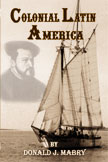Reviewed by Peter Winn
Lope de Aguirre was one of the most notorious and fascinating figures in the conquest of America, a megalomaniac and paranoid Basque soldier of iron will who murdered the leaders of the largest Peruvian expedition to search for El Dorado, descended the Amazon and conquered the island of Margarita (off Venezuela) from the astonished Spanish settlers, and then set off to conquer Peru before he was finally defeated and then killed by his own men. His story is the subject of a celebrated film by Werner Herzog. Now Stephen Minta has re-created Aguirre's journey in a book that is part history, part travelogue, but always interesting and well written.
A British scholar of Latin American literature, Minta retraced Aguirre's 16th century journey across South America with the contemporary chronicles in hand, and then wrote a book that weaves together the epic story of the conquistador with Minta's own experiences and observations of the places and people he encountered. The result is a delightful and insightful account of the little-known areas of the Andes and the Amazon, which narrates their history, along with that of the characters associated with them in the Aguirre story.
Minta begins, as Aguirre's expedition did, in Cuzco, the ancient Inca capital in the highlands of Peru, and ends in Onate, Aguirre's hometown in the mountains of Spain's Basque country. In between he descends the valleys of the Huallaga and Maranon rivers to the mighty Amazon, describing Iquitos and Manaus, the region's chief cities, as well as the smaller settlements he passes through along the way.
Rebel unto death
Yet, it is a measure of the power of Aguirre and his story that they increasingly dominate Minta's book. Through the eyes of contemporary chroniclers we see him murder his real or imagined enemies with a ruthlessness and sadism that still shocks centuries later, until there is no one left to kill but his beloved daughter, Elvira, whom he murders before he dies so that she would not become "a mere mattress for the unworthy." But Minta also shows that terror was not Aguirre's only hold over his men. The self styled "Wrath of God" was also the self-made "Prince of Freedom" who played on the resentment of soldiers who had conquered Peru only to see others appropriate the lion's share of the spoils. This is a duality that Aguirre maintained until the bitter end. When all hope was gone, he wrote an extraordinary letter to Philip II of Spain, the mightiest monarch of his day, in which he recounted and justified each of his crimes, and then signed it: "Son of faithful vassals from the Basque country, and rebel unto death because of your ingratitude, Lope de Aguirre, The Wanderer."
Aguirre is history that is truly stranger than fiction!
About the Author: STEPHEN MINTA is Senior Lecturer in Comparative Literature at the University of York.
About the Reviewer: PETER WINN teaches Latin American history at Tufts University. He is the author of Americas: The Changing Face of Latin America and the Caribbean.
This review was used with permission of Peter Winn and the History Book Club.
You can read about this and other topics in colonial Latin American history by buying and reading
 Colonial Latin America by Don Mabry.
Colonial Latin America by Don Mabry.
Click on the book cover or the title to go to Llumina Press.